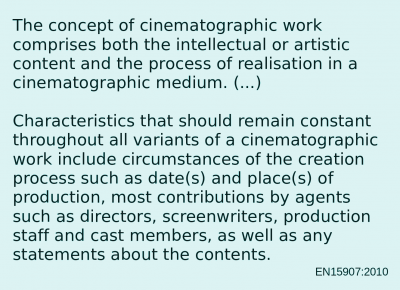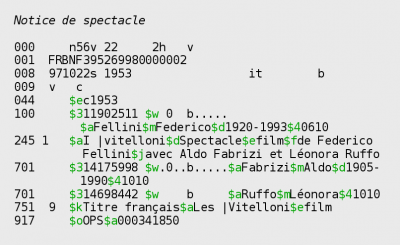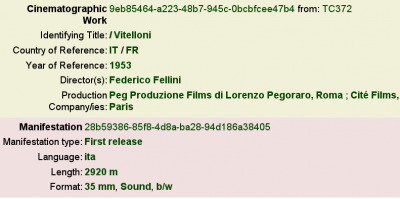Difference between revisions of "Description levels: A worked example"
From filmstandards.org
| Line 46: | Line 46: | ||
Here is the [http://filmstandards.org/demo/xml/vitelloni_01.xml XML record], the [http://filmstandards.org/demo/xml/v.php?f=/demo/xml/view1.xsl transformation script], and the [http://filmstandards.org/demo/xml/vitelloni_01_v.html resulting HTML] page. | Here is the [http://filmstandards.org/demo/xml/vitelloni_01.xml XML record], the [http://filmstandards.org/demo/xml/v.php?f=/demo/xml/view1.xsl transformation script], and the [http://filmstandards.org/demo/xml/vitelloni_01_v.html resulting HTML] page. | ||
| + | |} | ||
| + | |||
| + | {| style="float: right; border: 1px solid #BBB; margin: .46em 0 0 .2em;" | ||
| + | |- | ||
| + | | valign="top" width="405px" |[[File:Bnf-worklevel.png|400px]]<br /> | ||
| + | <span style="font-size:8pt"> | ||
| + | </span> | ||
| + | |||
| + | | valign="top" width="405px" | | ||
| + | This is an equivalent of a work-level record from the Bibliothèque nationale de France. In library cataloguing, such records define a '''uniform title''' to be used in describing manifestations that may have been published with a different title (e.g. translations of the work). | ||
| + | |||
| + | Note that the French title is given here as ''Les Vitelloni'', which differs from most other French sources. | ||
| + | |} | ||
| + | |||
| + | {| style="float: right; border: 1px solid #BBB; margin: .46em 0 0 .2em;" | ||
| + | |- | ||
| + | | valign="top" width="405px" |[[File:Vitelloni-manifestation.png|400px]]<br /> | ||
| + | <span style="font-size:8pt"> | ||
| + | </span> | ||
| + | |||
| + | | valign="top" width="405px" | | ||
| + | Very often, an elementary description of a film work also contains some basic information about the '''initial release''', usually referred to as the "original" version. | ||
| + | |||
| + | In EN 15907, this kind of information falls into the '''manifestation''' level. | ||
| + | |} | ||
| + | |||
| + | {| style="float: right; border: 1px solid #BBB; margin: .46em 0 0 .2em;" | ||
| + | |- | ||
| + | | valign="top" width="405px" |[[File:Vitelloni-view3.png|400px]]<br /> | ||
| + | <span style="font-size:8pt"> | ||
| + | </span> | ||
| + | |||
| + | | valign="top" width="405px" | | ||
| + | EN 15907 allows manifestations to be directly associated with a cinematographic work, or via a '''variant''' level. | ||
| + | |||
| + | Anticipating that we may want to distinguish between variants of this film work, we can '''insert a default Variant''' entity and associate our manifestation(s) with this. | ||
| + | |||
| + | Here is the [http://filmstandards.org/demo/xml/vitelloni_03.xml XML record], the [http://filmstandards.org/demo/xml/v.php?f=/demo/xml/view3.xsl transformation script], and the [http://filmstandards.org/demo/xml/vitelloni_03_v.html resulting HTML] page. | ||
|} | |} | ||
Revision as of 21:07, 4 April 2011
From the TC 372 Workshop Compendium
Description levels do not only offer new ways for user interaction with filmographic databases, but can also ecenomise the production of metadata.
|
<mediaplayer image='http://filmstandards.org/media/prossimamente2.jpg'>http://filmstandards.org/media/vitelloni-trailer-it.flv</mediaplayer>
|
This short piece is a trailer. For the moment, we will ignore the question if a trailer can be regarded as a version or variant of the work which it advertises, or if it is something entirely different. This trailer just serves to give us an idea of the work that will be discussed in the following. |
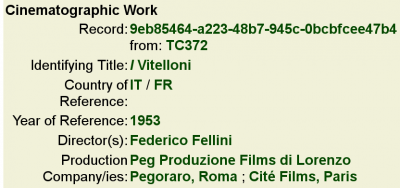
|
An elementary work-level description would comprise the elements from EN 15744 minus those that do not belong to the work level in EN 15907. The figure on the left gives an idea of what a minimum work-level description could look like. Here is the XML record, the transformation script, and the resulting HTML page. |
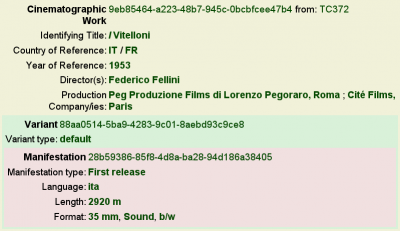
|
EN 15907 allows manifestations to be directly associated with a cinematographic work, or via a variant level. Anticipating that we may want to distinguish between variants of this film work, we can insert a default Variant entity and associate our manifestation(s) with this. Here is the XML record, the transformation script, and the resulting HTML page. |
